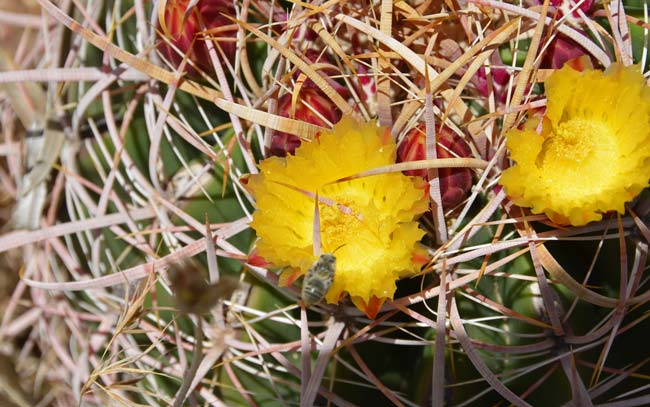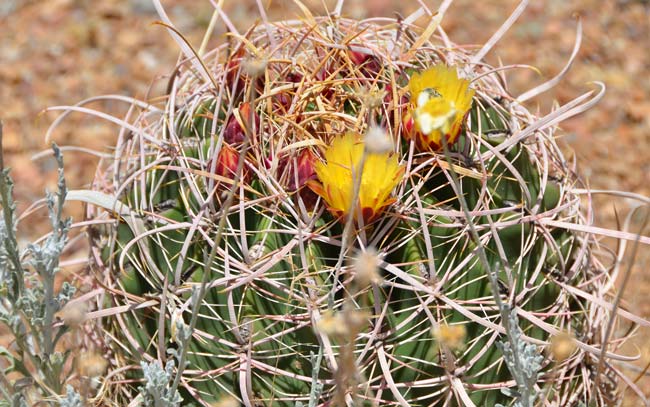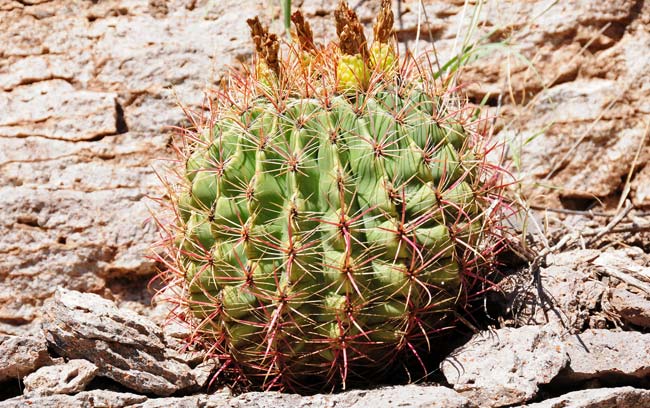Ferocactus wislizeni, Candy Barrelcactus



Scientific Name: Ferocactus wislizeni
Common Name: Candy Barrelcactus
Also Called: Arizona Barrel Cactus, Candy Barrel Cactus, Compass Barrel Cactus, Fishhook Barrel Cactus, Fishhook Barrel, Southwestern Barrel Cactus (Spanish: Biznaga de Agua, Viznaga Hembra)
Family: Cactaceae, Cactus Family
Synonyms: (Echinocactus wislizeni, Ferocactus wislizenii)
Status: Native
Duration: Perennial
Size: Up to 5 feet or more (10 feet).
Growth Form: Shrub or rarely tree; single stem, stems usually leaning southward on mature plants; depressed-spheric to ovoid-cylindric.
Leaves: Leaves modified into spines emerging from areoles; lacking glochids; 16 to 25 spines per areole, the central spine is the largest with smaller radial spines dull pink, gray, tan and the smallest spines are white, slender and almost bristle like.
Flower Color: Yellow, red or orange; large and showy, almost 2 inches long and 3 inches wide; inner tepals also orange, red or yellow with orange to red mid-stripes, stigma lobes yellow, orange or red; fruit bright yellow, readily dehiscent through basal pore, leathery or fleshy, hollow except for seeds.
Flowering Season: July to September.
Elevation: 300 to 5,500 feet.
Habitat Preferences: Desert scrub, flats, bajadas, rocky areas, mountainsides, grasslands, south-facing slopes on lower edges of oak woodlands.
Recorded Range: In the United States Ferocactus wislizeni is found in AZ, NM, TX. It is also native to northwestern Mexico. In Arizona it is found in the central and southern parts of the state.
North America & US County Distribution Map for Ferocactus wislizeni.
U.S. Weed Information: No information available.
Invasive/Noxious Weed Information: No information available.
Wetland Indicator: No information available.
Threatened/Endangered Information: Arizona: Ferocactus cylindraceus is salvage restricted.
Genus Information: In North America there are 6 species and 6 accepted taxa overall for Ferocactus. Worldwide, The Plant List includes 24 accepted species names and a further 149 scientific names of infraspecific rank for the genus.
In the Southwestern United States: Arizona has 4 species of Ferocactus, California, New Mexico and Texas each have 2 species, Nevada and Utah each have 1 species. All data is approximate and subject to taxonomic changes.
Comments: Candy Barrelcactus has a strong tendency to lean toward the south as adult and will often fall over pulling the roots out of the ground. Rotting plants play host to an entire ecosystem of insects and fungi. Another very large species of Barrel Cactus is Emory's Barrel Cactus, F. emoryi (covillei) which also blooms about the same time and has overlapping ranges.
To date there is little or no documentation to suggest that this species hybridizes with California Barrel Cactus, F. cylindraceus however there are claims in the literature for claiming hybridization between these two species as an answer to confusion between identification of species in areas of overlap.
Importance to Wildlife; Candy Barrel Cactus is eaten by Mule Deer, Javelina (sometimes called Collared Peccary) and livestock. Rabbits will eat the plants of the spines have been eliminated, especially through range fire. The seeds readily attract birds and small mammals.
For a comprehensive thoroughly documented review of Ferocactus wislizeni see the USDA USFS Fire Effects Information System, or FEIS.
In Southwest Desert Flora also see: California Barrel Cactus Ferocactus cylindraceus.
California Barrel Cactus has been used for food and traded by southwestern United States indigenous peoples.
See complete listing of ethno-botanical uses at Native American Ethnobotany, University of Michigan, Dearborn.

